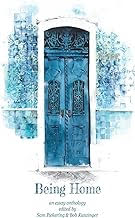| Being Home: An Anthology
I hate my kitchen sink. No, really. I despise it. When I’m in the kitchen—and I’m not too fond of that, either—I avoid eye contact with the sink, as if it were a petty rival. I’m aware, deeply aware, of its deficiencies, and instead of politely overlooking them, I sneer when they are displayed. “Piece of shit,” I say under my breath when I can’t fit my mixing bowl under the faucet for a decent rinse. I sigh with unconcealed impatience at the anemic stream from the hand-held sprayer. The two little windows above the sink are shamefully inadequate. The sill outside is covered in mildew. The windows themselves are the kind that crank in and out, the kind that get stuck when I forget and open them more than six inches when I’m desperate for fresh air, for space, for something my eyes can safely settle upon. The biggest flaw with the windows is that they face north. Looking out of them is like reading with a dim bulb: my eyes alternately squint and widen in an effort to conserve and, at the same time, capture more light, a commodity which is in short supply in this land of grey and shrinking skies. When people come over, they’re not immediately horrified by the dark hole of my kitchen with its offending sink. “Oh, what a nice place this is,” they say, as they take in the wide planks of pine on the floor, the fireplace and the built-in bookcases. They don’t see what I see, and they have no concept at all of what desolation there is in what I don’t see every time I step into this room. My reaction might seem just a tad over the top. I know my reaction is over the top. But knowing that doesn’t help me at all. This isn’t really about the sink, of course. The real problem is that I can’t see the horizon. Montana, where we used to live, is defined not by its boundaries but by the lack of them. We measured distances by mountain range, and we were so much more aware of the four cardinal directions—north, south, east, west—because there was just so much more of each one. West was never just “that way.” For me, standing in my house, west was the pasture outside our living room windows where one spring, before the snow melted in the mountains, a moose gave birth to twins in the dry bed of the irrigation ditch. Farther west, the pasture stretched past our property line and ranged across the flat of the plain, interrupted only by cottonwood trees lined up single file along the sparse network of roads and ditches. Even farther west, the land lifted and plunged like the sea: green, brown or white, depending on the season, lapping up against the Absaroka Mountains and spilling beyond. Whole towns were hidden down in the troughs of the hills, which rolled on to the Gallatin Range. The city of Bozeman lay behind this, and more mountains. Finally, the western sun set after its long trip and hung suspended at the last moment for encore after encore of radiant sky. With a horizon like that, the only obstacles were the limits of my own imagination. |
